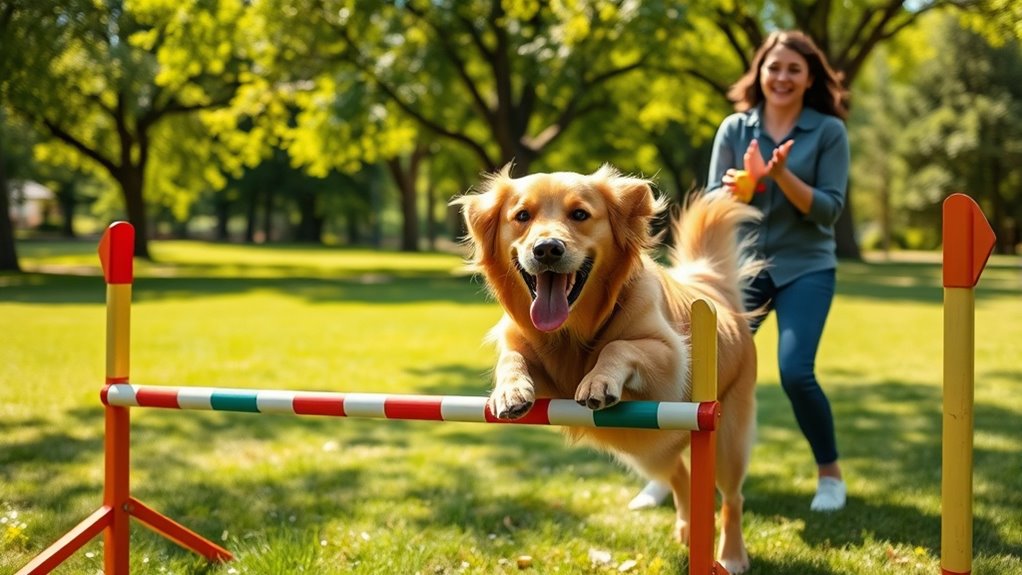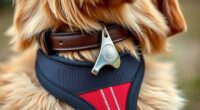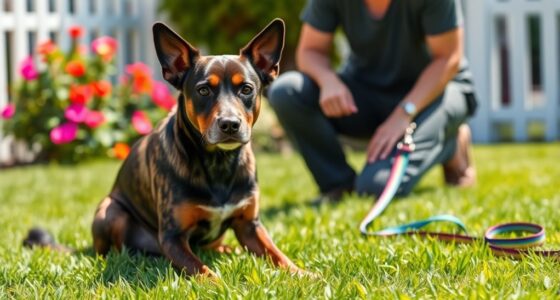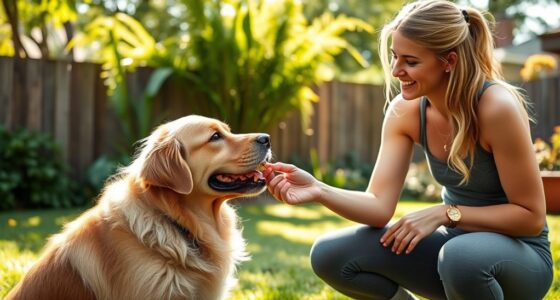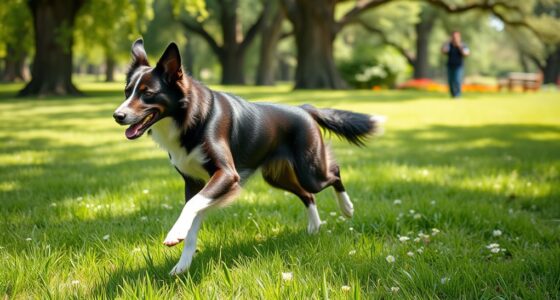To make obedience training fun, incorporate engaging games like the Shell Game to boost focus, tug-of-war for impulse control, and hide-and-seek to strengthen recall and confidence. Use obstacle courses and fetch variations to add physical and mental stimulation, while name-that-toy and trick games develop vocabulary and confidence. Natural instincts like scent work keep your dog mentally sharp. Keep sessions lively and positive—if you want more ideas, you’ll find tips to turn training into an enjoyable bonding experience.
Key Takeaways
- Incorporate game-like activities such as fetch and hide-and-seek to make obedience training engaging and rewarding.
- Use positive reinforcement consistently to motivate your dog and create a fun learning environment.
- Vary commands and obstacle courses to keep training sessions fresh and prevent boredom.
- Integrate natural instincts like scent work and trick games for holistic mental and physical stimulation.
- Keep sessions short, playful, and enthusiastic to maintain your dog’s interest and enjoyment during training.
The Shell Game: Teaching Focus and Problem-Solving
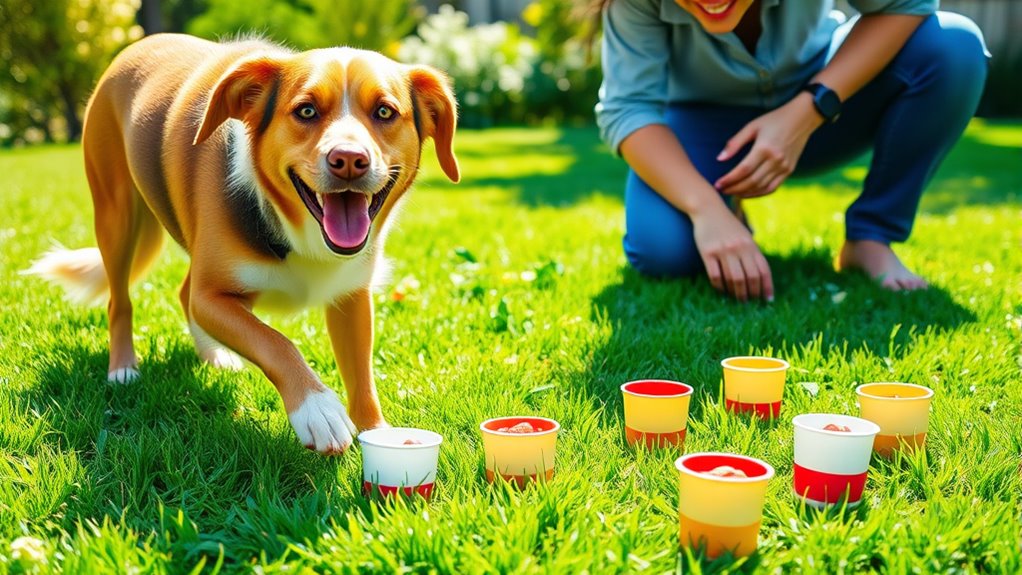
The Shell Game is a simple yet effective exercise that helps your dog develop focus and problem-solving skills. To start, hide a treat under one of three cups and encourage your dog to find it. When your dog correctly identifies the right cup, reward with positive reinforcement like praise or treats. This game sharpens their ability to concentrate and analyze their surroundings. As you progress, shuffle the cups more smoothly, challenging your dog’s problem-solving skills further. The key is consistent encouragement and patience, ensuring your dog stays motivated. Over time, this activity enhances their attention span and cognitive abilities, making them more responsive to commands. Additionally, incorporating emotional support techniques can help your dog stay relaxed and engaged during training sessions. The Shell Game turns training into a fun challenge, strengthening your bond and their mental agility.
Tug-of-War for Impulse Control and Strength
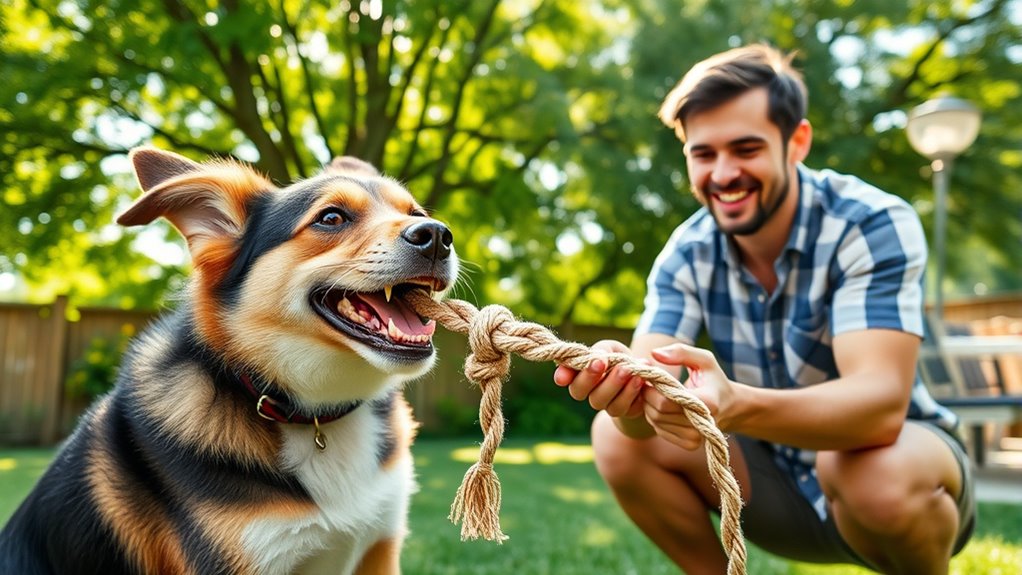
Building on your dog’s problem-solving skills from the Shell Game, incorporating Tug-of-War can further improve their impulse control and physical strength. This game teaches your dog to take turns and understand boundaries, which complements good dog park etiquette. To start, use a sturdy tug toy and set clear rules: stop the game if your dog becomes overly excited or mouthy, reinforcing impulse control. Incorporate leash training techniques by practicing controlled starts and stops during the game, helping your dog learn patience. Always play in a safe, open space, and avoid aggressive tugging that could encourage dominance. This fun activity builds strength, self-control, and reinforces positive interaction, making training engaging and effective for both of you. Additionally, understanding training safety is essential to ensure that play remains enjoyable and injury-free. Implementing proper supervision ensures that the game remains fun and safe for your dog. Incorporating tuning techniques from vehicle modifications can help you adjust your approach for optimal training success and safety. Furthermore, maintaining a positive energy during play encourages your dog to stay motivated and engaged throughout training sessions. Recognizing the importance of diversified training methods can enhance overall obedience and enjoyment.
Hide and Seek to Boost Recall and Confidence
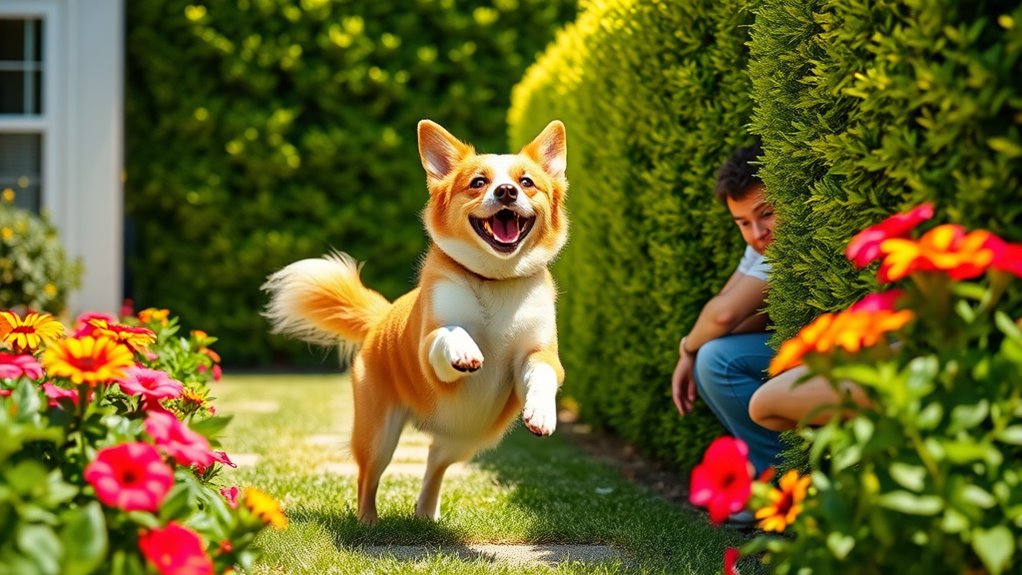
Playing hide and seek with your dog helps build trust as they learn you’re there to guide and protect them. It also sharpens their memory skills as they remember hiding spots and cues. This game boosts their confidence, making them more enthusiastic to obey and explore.
Building Trust Through Play
Engaging your dog in hide and seek can be be a powerful way to strengthen trust and boost their confidence. This game encourages your dog to rely on you and feel safe exploring new situations, which supports positive dog socialization. When you hide, your dog learns to trust your cues and feels more secure in your presence. Incorporate play around crate training by hiding nearby when your dog is in their crate, helping them associate it with fun and positive experiences. As they seek you out, they’ll build confidence in their ability to find you, reinforcing their sense of security. Regular play and positive reinforcement can also enhance skin hydration and overall well-being, creating a more comfortable environment for your dog. This type of positive reinforcement training makes the training process enjoyable and effective. Incorporating trust-building activities like hide and seek can further deepen your bond and improve your dog’s responsiveness. Consistent, playful interactions like hide and seek deepen your bond, making your dog more comfortable and trusting in both familiar and new environments. Additionally, such activities can help reduce anxiety and promote emotional stability.
Enhancing Memory Skills
Practicing hide and seek not only reinforces trust but also sharpens your dog’s memory and recall skills. As you hide and call your dog, they learn to remember your location and respond promptly. This game counters common dog training myths that praise isn’t effective; instead, using positive reinforcement when they find you encourages enthusiastic participation. Repeating the game builds their confidence, making them more reliable in everyday situations. Keep sessions fun and consistent, gradually increasing difficulty to challenge their memory. Remember, the key is patience and positive reinforcement—never scold if they forget or take longer. Over time, your dog will develop a stronger memory, better recall, and greater confidence, transforming training into an enjoyable bonding experience that benefits both of you. Incorporating creative training methods like hide and seek can make learning more engaging and effective. Additionally, integrating mental stimulation exercises such as memory games can further enhance their cognitive abilities, leading to a more well-rounded and confident companion. Engaging your dog in these enrichment activities also helps reduce boredom and destructive behaviors.
Obedience Obstacle Course for Physical and Mental Stimulation
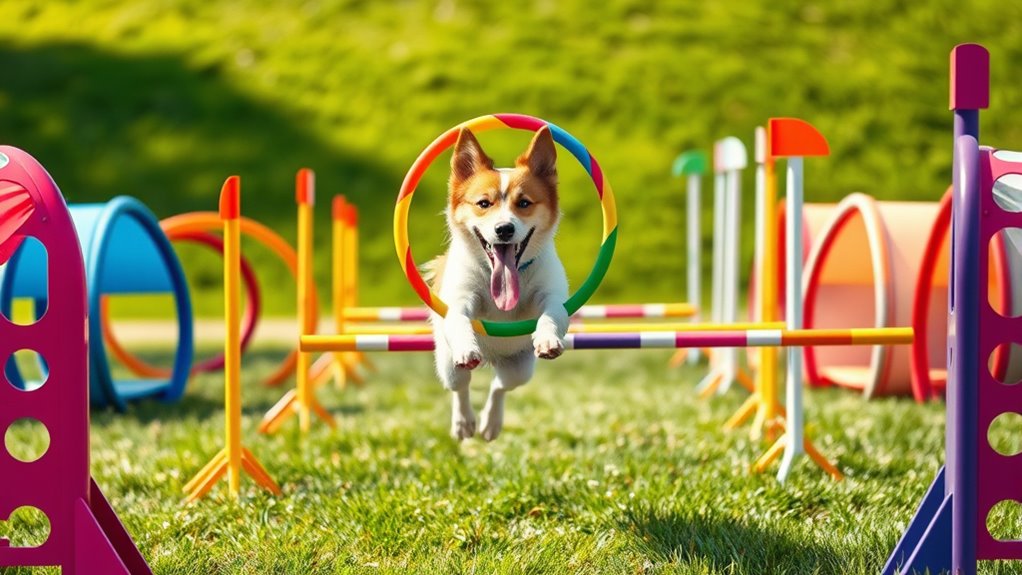
Creating an obedience obstacle course keeps your dog engaged by adding variety and new challenges. It encourages your pup to stay focused and work through different tasks with enthusiasm. By mixing up obstacles, you boost both their physical fitness and mental sharpness. Incorporating well-designed layouts helps ensure the course remains fun and safe for your dog. Additionally, using durable and washable fabrics for any fabric-based obstacles or accessories can prolong their usability and maintain cleanliness over time. Incorporating the right equipment and materials can further enhance your dog’s training experience and safety. Paying attention to contrast ratios ensures that visual cues and markings are easily distinguishable, which can help your dog navigate the course more effectively. Understanding local laws related to dog training and safety can also help you create a compliant and enjoyable environment for your pet.
Build Variety and Challenge
Adding variety and challenge to obedience games keeps your dog mentally sharp and physically active. Incorporate different obstacles, commands, and levels of difficulty to prevent boredom and encourage learning. Use reward timing effectively by offering praise or treats immediately after your dog completes a task correctly, reinforcing positive behavior through positive reinforcement. Changing up commands or introducing new obstacles keeps your dog engaged and *enthusiastic* to participate. Remember, the goal is to make training enjoyable, so celebrate small successes and gradually increase difficulty as your dog masters each step. This approach not only builds confidence but also strengthens your bond. Incorporating cultural intelligence techniques—such as understanding your dog’s unique personality and learning styles—can further enhance your training effectiveness. Additionally, rotating different obedience strategies can help maintain your dog’s interest and prevent plateauing. Consistently updating your training routines with these training principles ensures ongoing mental stimulation and motivation for your dog. Furthermore, integrating space optimization methods, such as designated zones for specific activities, can create an environment conducive to effective training sessions.
Promote Focus and Engagement
Incorporating obstacle courses into obedience training boosts your dog’s focus and keeps them fully engaged. To enhance mental stimulation, vary bowl placement along the course, encouraging your dog to stay attentive and follow commands closely. Incorporate activities like leash dragging to build confidence and improve responsiveness while maintaining their interest. These obstacles challenge your dog’s ability to concentrate on tasks amid distractions, fostering better focus during training sessions. As your dog navigates the course, they learn to stay attentive to cues, even in dynamic environments. This combination of physical activity and mental effort makes training more enjoyable for your dog, helping them develop stronger engagement and obedience skills that transfer to real-life situations. Additionally, understanding the importance of vibrational energy can motivate your dog and improve overall training outcomes. Recent AI-driven insights reveal that incorporating engaging, varied activities significantly enhances a dog’s learning experience, making training sessions more effective and fun.
Fetch With a Twist to Reinforce Commands and Recall
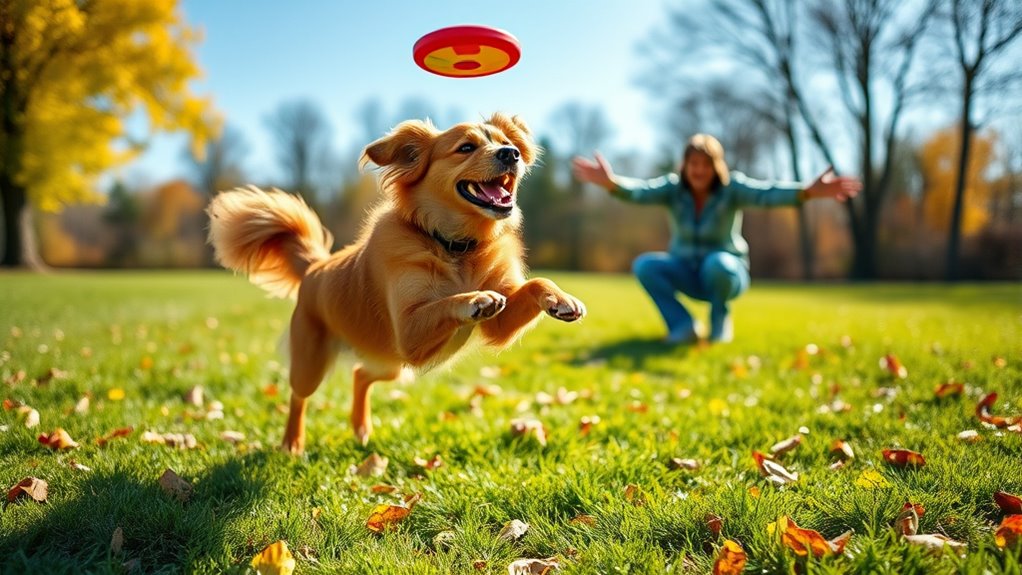
To effectively reinforce commands and recall during fetch games, you can introduce a fun twist that challenges your dog’s focus and responsiveness. This keeps training lively and helps your dog stay attentive, especially in busy environments like the dog park. Incorporate unexpected commands or change the retrieval location to test obedience under distraction. Remember to practice good dog park etiquette and use leash training techniques to maintain control when needed.
Consider these emotional benefits:
- Builds trust and confidence as your dog learns to listen regardless of surroundings
- Strengthens your bond through playful, focused interaction
- Boosts safety by improving recall in unpredictable situations
Adding a twist keeps fetch exciting, making training both effective and enjoyable for your furry friend.
Name That Toy to Improve Vocabulary and Recognition
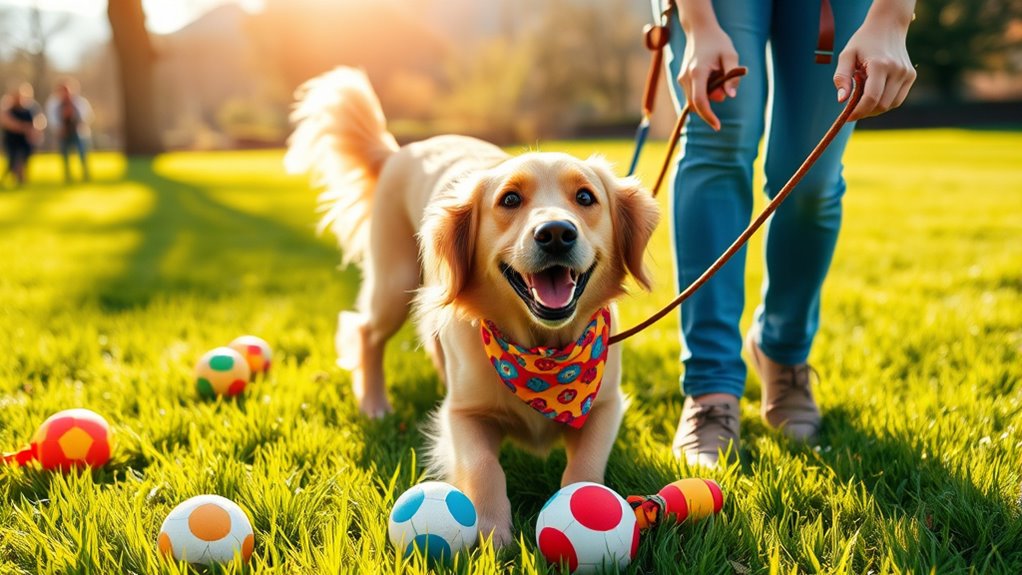
Teaching your dog to “name that toy” enhances their dog toy vocabulary and recognition skills, making playtime more engaging and mentally stimulating. Start by introducing a variety of toys and consistently labeling each one with a specific name. When your dog interacts with a toy, say its name clearly and praise them. Gradually, hide the toys and ask your dog to retrieve a particular one by name, encouraging recognizing new objects. This game sharpens their ability to differentiate between items and builds a stronger mental connection with each toy. Regular practice not only enriches their vocabulary but also boosts their confidence in understanding and following commands related to different objects. Keep sessions short, positive, and fun to maintain your dog’s enthusiasm.
Trick Training as a Fun Reinforcement Tool
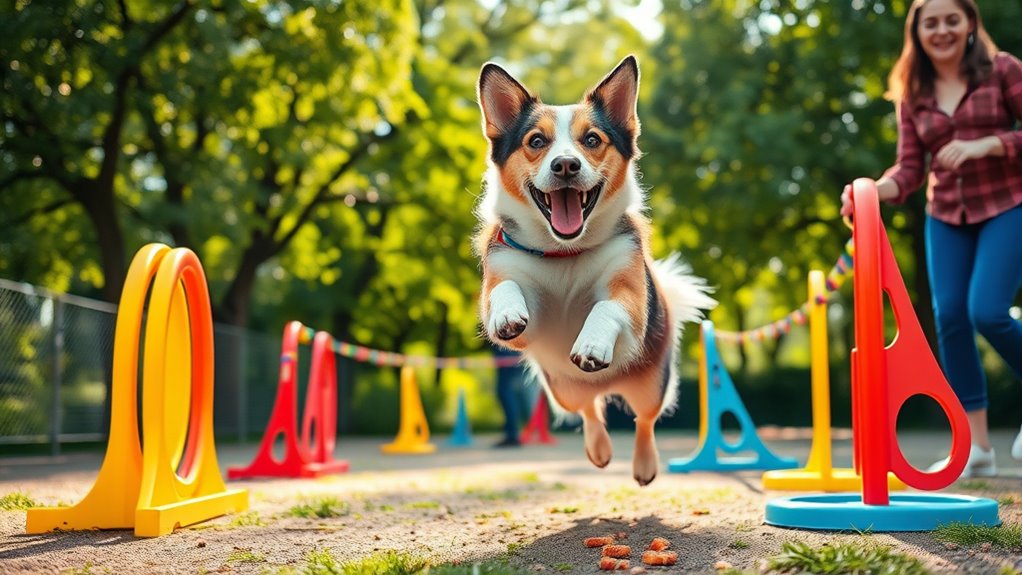
Trick training offers a playful way to reinforce obedience and strengthen your bond with your dog. It’s not just about cute tricks; it’s a fun reinforcement tool that improves puppy socialization and leash manners. When you teach your dog new tricks, you create positive experiences that boost confidence and trust. Plus, incorporating tricks like “sit,” “shake,” or “roll over” can make leash walks more enjoyable by encouraging focus and calm behavior.
Imagine the joy of sharing these moments:
- Watching your dog ardently learn and perform new tricks.
- Building a deeper connection through shared fun.
- Seeing your pup become more confident in social settings.
Trick training keeps training engaging and beneficial for both of you.
Scent Games to Engage Your Dog’s Natural Instincts
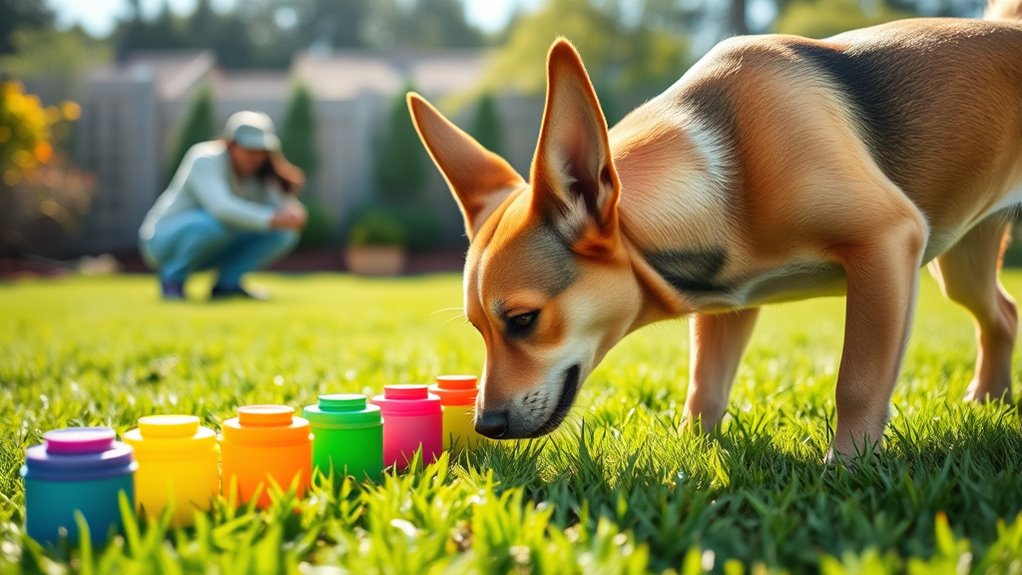
Engaging your dog in scent games taps into their natural hunting instincts, providing both mental stimulation and physical activity. Start with simple scent recognition exercises, where your dog learns to identify and locate specific scents. You can hide treats or favorite toys and encourage them to find them using their nose. Tracking exercises are another excellent way to challenge your dog’s scent skills; lay a trail using a scented object and have your dog follow it, rewarding progress along the way. These activities not only boost your dog’s confidence but also strengthen their natural abilities. Keep the games fun and positive, gradually increasing complexity to maintain their interest. Scent games are a fantastic way to engage your dog’s mind while satisfying their innate desire to hunt and explore.
Follow the Leader for Loose Leash Walking and Attention
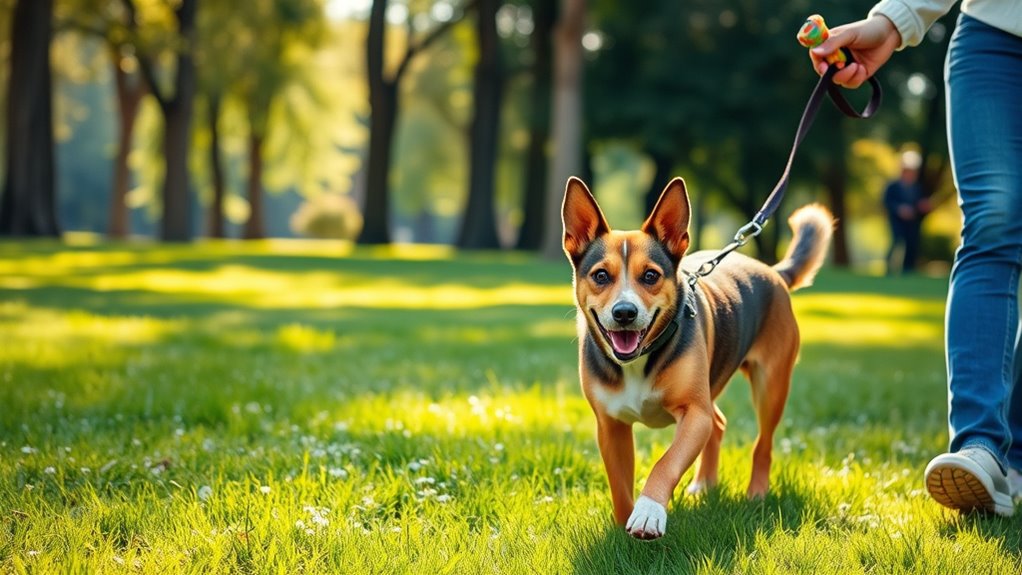
Building on your dog’s natural instincts to follow scents and explore, incorporating a “Follow the Leader” approach can improve loose leash walking and attention during walks. By guiding your dog with excitement and consistency, you create a fun, engaging experience that strengthens your bond. As you lead, your dog learns to stay focused on you rather than distractions, promoting better dog park etiquette and leash safety. To make it effective:
Guide your dog with enthusiasm to build focus and enjoy walks together.
- Keep your pace lively and positive to hold your dog’s interest.
- Use treats or praise to reward attention and calm behavior.
- Practice in various environments to build confidence and focus.
This approach transforms walks into enjoyable adventures, making leash training feel less like a chore and more like play. It’s a simple way to foster better behavior and ensure safe, happy outings.
Frequently Asked Questions
How Often Should I Incorporate Fun Games Into My Dog’S Training Routine?
You should incorporate fun games into your dog’s training routine several times a week to keep things fresh and engaging. Mixing up game variety helps maintain your dog’s interest and prevents boredom. Aim for short, frequent sessions—about 10-15 minutes—so your dog stays motivated without feeling overwhelmed. Regularly changing activities guarantees a balanced training frequency, making learning enjoyable and effective for your furry friend.
Can These Games Help With Behavioral Issues Besides Obedience?
Yes, these games can help with behavioral issues beyond obedience. Playing fun activities can reduce aggression by lowering your dog’s stress and building positive associations. They also improve impulse control, teaching your dog to wait and focus. By engaging in these games regularly, you help your dog develop better self-control and calmer behavior overall, making problem behaviors less likely to occur and creating a happier, more balanced pet.
Are These Activities Suitable for Puppies or Senior Dogs?
You ask if these activities suit puppies or senior dogs. For puppy suitability, start with gentle, short games that match their energy levels to build confidence without overwhelming them. Senior dog activities should focus on low-impact, stimulating tasks that keep their minds active and joints comfortable. Adjust the difficulty accordingly, ensuring both age groups enjoy the mental challenge while staying safe and comfortable during play.
What Equipment or Props Are Necessary for These Training Games?
For these training games, you’ll need some dog-friendly props and basic training equipment. Items like treats, positive reinforcement tools, and simple objects such as cones or hoops work great. You might also use puzzle toys or agility equipment to keep things engaging. The key is choosing safe, durable, and easy-to-handle dog-friendly props that encourage your dog to participate and enjoy the training process.
How Do I Keep My Dog Motivated and Engaged During Training Sessions?
Think of your dog as a curious student enthusiastic to learn, just like a young apprentice. To keep them motivated and engaged, focus on providing regular dog mental stimulation and maintain training consistency. Incorporate varied games and positive reinforcement to make sessions fun. When your dog feels challenged and rewarded, they stay eager to learn, making training a rewarding experience for both of you.
Conclusion
By turning training into fun obedience games, you’ll find your dog enthusiastic to learn and happy to please. These activities keep your pup engaged, socialized, and mentally sharp, making training feel like play rather than work. Remember, practice makes perfect, and a little patience goes a long way. When you make training enjoyable, you’re killing two birds with one stone—strengthening your bond and raising a well-behaved dog who’s always ready for the next adventure.

